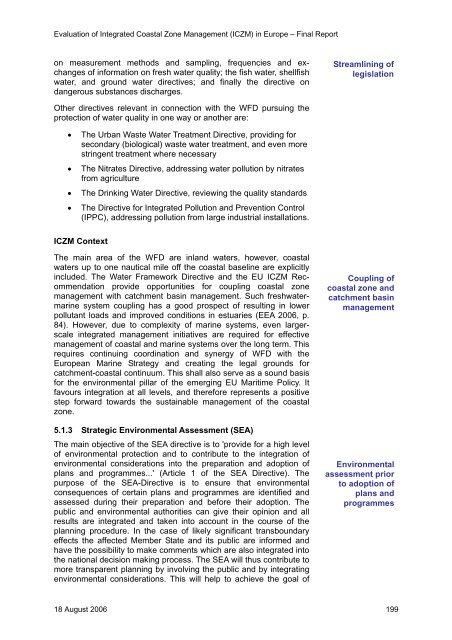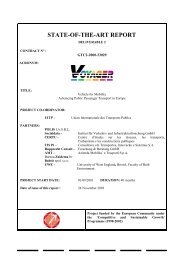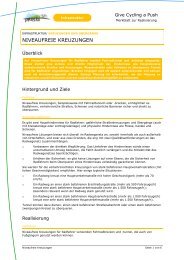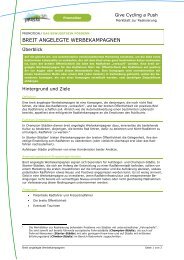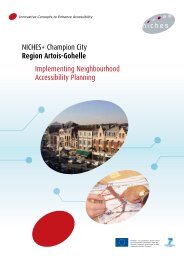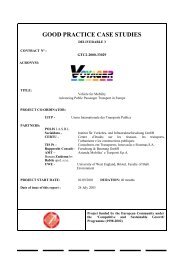Evaluation of Integrated Coastal Zone Management (ICZM) in ...
Evaluation of Integrated Coastal Zone Management (ICZM) in ...
Evaluation of Integrated Coastal Zone Management (ICZM) in ...
Create successful ePaper yourself
Turn your PDF publications into a flip-book with our unique Google optimized e-Paper software.
<strong>Evaluation</strong> <strong>of</strong> <strong>Integrated</strong> <strong>Coastal</strong> <strong>Zone</strong> <strong>Management</strong> (<strong>ICZM</strong>) <strong>in</strong> Europe – F<strong>in</strong>al Report<br />
on measurement methods and sampl<strong>in</strong>g, frequencies and exchanges<br />
<strong>of</strong> <strong>in</strong>formation on fresh water quality; the fish water, shellfish<br />
water, and ground water directives; and f<strong>in</strong>ally the directive on<br />
dangerous substances discharges.<br />
Streaml<strong>in</strong><strong>in</strong>g <strong>of</strong><br />
legislation<br />
Other directives relevant <strong>in</strong> connection with the WFD pursu<strong>in</strong>g the<br />
protection <strong>of</strong> water quality <strong>in</strong> one way or another are:<br />
• The Urban Waste Water Treatment Directive, provid<strong>in</strong>g for<br />
secondary (biological) waste water treatment, and even more<br />
str<strong>in</strong>gent treatment where necessary<br />
• The Nitrates Directive, address<strong>in</strong>g water pollution by nitrates<br />
from agriculture<br />
• The Dr<strong>in</strong>k<strong>in</strong>g Water Directive, review<strong>in</strong>g the quality standards<br />
• The Directive for <strong>Integrated</strong> Pollution and Prevention Control<br />
(IPPC), address<strong>in</strong>g pollution from large <strong>in</strong>dustrial <strong>in</strong>stallations.<br />
<strong>ICZM</strong> Context<br />
The ma<strong>in</strong> area <strong>of</strong> the WFD are <strong>in</strong>land waters, however, coastal<br />
waters up to one nautical mile <strong>of</strong>f the coastal basel<strong>in</strong>e are explicitly<br />
<strong>in</strong>cluded. The Water Framework Directive and the EU <strong>ICZM</strong> Recommendation<br />
provide opportunities for coupl<strong>in</strong>g coastal zone<br />
management with catchment bas<strong>in</strong> management. Such freshwatermar<strong>in</strong>e<br />
system coupl<strong>in</strong>g has a good prospect <strong>of</strong> result<strong>in</strong>g <strong>in</strong> lower<br />
pollutant loads and improved conditions <strong>in</strong> estuaries (EEA 2006, p.<br />
84). However, due to complexity <strong>of</strong> mar<strong>in</strong>e systems, even largerscale<br />
<strong>in</strong>tegrated management <strong>in</strong>itiatives are required for effective<br />
management <strong>of</strong> coastal and mar<strong>in</strong>e systems over the long term. This<br />
requires cont<strong>in</strong>u<strong>in</strong>g coord<strong>in</strong>ation and synergy <strong>of</strong> WFD with the<br />
European Mar<strong>in</strong>e Strategy and creat<strong>in</strong>g the legal grounds for<br />
catchment-coastal cont<strong>in</strong>uum. This shall also serve as a sound basis<br />
for the environmental pillar <strong>of</strong> the emerg<strong>in</strong>g EU Maritime Policy. It<br />
favours <strong>in</strong>tegration at all levels, and therefore represents a positive<br />
step forward towards the susta<strong>in</strong>able management <strong>of</strong> the coastal<br />
zone.<br />
5.1.3 Strategic Environmental Assessment (SEA)<br />
The ma<strong>in</strong> objective <strong>of</strong> the SEA directive is to 'provide for a high level<br />
<strong>of</strong> environmental protection and to contribute to the <strong>in</strong>tegration <strong>of</strong><br />
environmental considerations <strong>in</strong>to the preparation and adoption <strong>of</strong><br />
plans and programmes...' (Article 1 <strong>of</strong> the SEA Directive). The<br />
purpose <strong>of</strong> the SEA-Directive is to ensure that environmental<br />
consequences <strong>of</strong> certa<strong>in</strong> plans and programmes are identified and<br />
assessed dur<strong>in</strong>g their preparation and before their adoption. The<br />
public and environmental authorities can give their op<strong>in</strong>ion and all<br />
results are <strong>in</strong>tegrated and taken <strong>in</strong>to account <strong>in</strong> the course <strong>of</strong> the<br />
plann<strong>in</strong>g procedure. In the case <strong>of</strong> likely significant transboundary<br />
effects the affected Member State and its public are <strong>in</strong>formed and<br />
have the possibility to make comments which are also <strong>in</strong>tegrated <strong>in</strong>to<br />
the national decision mak<strong>in</strong>g process. The SEA will thus contribute to<br />
more transparent plann<strong>in</strong>g by <strong>in</strong>volv<strong>in</strong>g the public and by <strong>in</strong>tegrat<strong>in</strong>g<br />
environmental considerations. This will help to achieve the goal <strong>of</strong><br />
Coupl<strong>in</strong>g <strong>of</strong><br />
coastal zone and<br />
catchment bas<strong>in</strong><br />
management<br />
Environmental<br />
assessment prior<br />
to adoption <strong>of</strong><br />
plans and<br />
programmes<br />
18 August 2006 199


